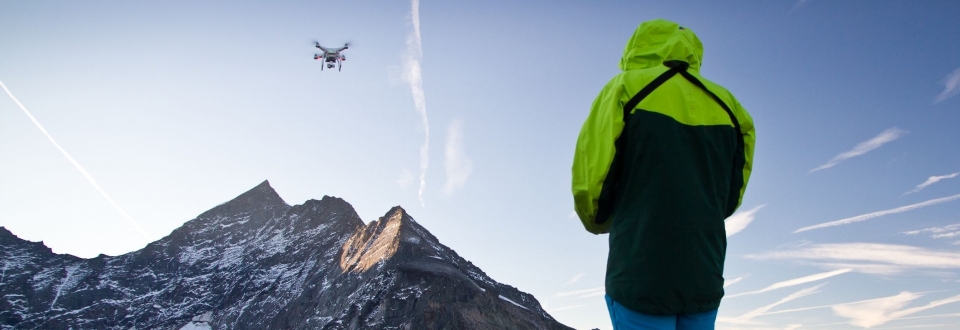PROJECT CirqueMonHT
The Influence of Glacier Randkluft Systems on Rockfall
Glacierized cirques are defining high-alpine landscape elements which react particularly sensitively to climatic changes such as rising temperatures or an increase in the proportion of liquid precipitation. Most cirque glaciers are thinning rapidly, and hence, are constantly exposing fresh headwall sections, often featuring drastically changed thermal and rock mechanical boundary conditions. For such freshly exposed sections which frequently are oversteepened and underlain by permafrost, rockfall activity has been documented to be particularly high and hence, poses a considerable risk factor for man and infrastructure which is expected to only increase in the foreseeable future. However, due to the complete lack of robust, long-term data, further assessment of this risk factor is subject to considerable uncertainty.
To address this knowledge gap, CirqueMonHT has established an extensive environmental monitoring system at the Ödenwinkelkar (Stubach valley, Salzburg), a glacial cirque typical of the Hohe Tauern range. Stability relevant temperature changes in bedrock surfaces exposed by recent glacier retreat are monitored in various measurement transects. To simultaneously monitor bedrock stresses, joint aperture changes are recorded in selected locations. High-precision remote sensing techniques, such as laserscanning and photogrammetry, are used to localize and quantify rockfall release zones. Ice temperature and ice velocity measurements are employed to analyze glacial ablation dynamics, enabling an accurate estimation of future glacier behavior close to the headwall. The meso climate within the cirque is recorded by several weather stations, allowing to assess the significant influence of topographic shading effects and local wind conditions.
The consequences of climate change usually become apparent only after long response times. Thus, a comprehensive understanding of increased rockfall activity in freshly exposed headwall sections requires monitoring periods of sufficient length. CirqueMonHT therefore explicitly strives towards a long-term monitoring of relevant processes at decadal scale and towards the integration of existing glaciological and hydrological datasets.
PROFILE
Contribution GEORESEARCH: Project Co-Lead
Project Partners: Landesgeologie Salzburg, Technical University Munich (TUM), University of Salzburg, Institute for Interdisciplinary Mountain Research (IGF), imBERG CONSULT GmbH
Project Duration: 2017 - 2019
Funding: Arbeitsgemeinschaft Alpenländer (ARGE ALP)
PROJECT PARTNERS
Geological Service Salzburg
Technical University Munich, Landslide Research Group
Institute for Interdisciplinary Mountain Research
Working Group of the Alpine Countries (ARGE ALPE)
WORKSHOP Rudolfshütte

Rockfalls in high alpine regions, especially in the area of retreating glaciers, are a growing problem. 25 geotechnicians, engineers and scientists met on this subject to discuss influencing factors, trigger mechanisms and the main conclusions for practice. The workshop was carried out as part of the ARGE ALP project "The Influence of Glacier Randkluft Systems on Rockfall" at the Rudolfshütte (Salzburg, Austria) on 18./19. September 2019. Thank you for your participation and constructive contributions!
FIELDWORK Randkluft Ödenwinkelkees

Successful field mission at the foot of the mighty Eiskögele north face, Hohe Tauern Range! Together with our colleagues from Landesgeologie Salzburg we expanded our rock and ice temperature monitoring inside the randkluft systems of the Ödenwinkelkees glacier. More info on our ArgeAlp project 'CirqueMonHT' is available here...
more details ...
SELECTED REFERENCES
Hartmeyer I., Keuschnig M., Pläsken R., Rau M., Delleske R., Dörfler M., Krautblatter M., Burger D. (2021): Der Einfluss von Gletscher-Randklüften auf Felsstürze. Projektendbericht - Fördergeber: ARGE ALP, 58 Seiten, Salzburg.
Gletscherforschung in Uttendorf (23.05.2020): ORF2 - Salzburg heute
Gletscherschwund destabilisiert Felsen im Hochgebirge (23.05.2020): Der Standard
Problemzonen im Hochgebirge unter Beobachtung (17.05.2020): Land Salzburg
Forschung im Hochgebirge: Immer mehr Felsstürze auf Grund des Klimawandels (17.05.2020): Salzburger Nachrichten
Steigende Temperaturen lassen Felsen bröckeln (17.05.2020): Salzburg24
Problemzonen im Hochgebirge unter Beobachtung (17.05.2020): Meinbezirk.at
Permafrost - Auftauprozess nimmt immer höheres Tempo auf (21.10.2019): Salzburger Nachrichten
Arge Alp Arbeitet an Felssturz-Frühwarnsystem im Pinzgau (24.04.2018): Salzburger Nachrichten
Hartmeyer I., Keuschnig M., Fegerl L., Valentin G., Helfricht K., Otto J.-C. (2017): Long-term monitoring of climate-sensitive cirques in the Hohe Tauern range. Talk at the 6th International Symposium for Research in Protected Areas 2017, Salzburg, Österreich.




